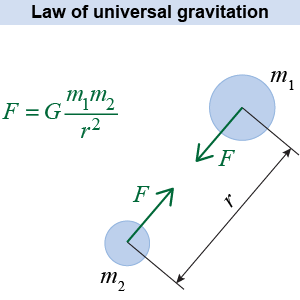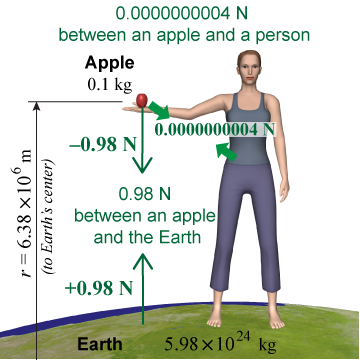|
Newton correctly deduced that an attractive gravitational force exists between all objects that have mass. The gravitational force is a universal force that exists between any two objects that contain mass. The strength of the gravitational force depends on the mass of the objects and the square of the distance between them. The equation Newton derived for gravity is called the law of universal gravitation. 
|
| (7.5) | | | F | = | force (N) | | G | = | gravitational constant | | | = | 6.67×10−11 N m2/kg2 | | m1 | = | mass of object #1 (kg) | | m2 | = | mass of object #2 (kg) | | r | = | distance between centers (m) |
| Law of universal gravitation
|
|
 Equation (7.5) says that the attractive force between two masses (m1 and m2) is proportional to the mass of both objects multiplied together. If one object doubles in mass, then the force between the objects doubles. If both objects double in mass, then the force of gravity between them is multiplied by four. The force is inversely proportional to the square of the radial distance r between the masses. This means that increasing the distance by a factor of 2 decreases the force by (1/2)2 = 1/4.
Equation (7.5) says that the attractive force between two masses (m1 and m2) is proportional to the mass of both objects multiplied together. If one object doubles in mass, then the force between the objects doubles. If both objects double in mass, then the force of gravity between them is multiplied by four. The force is inversely proportional to the square of the radial distance r between the masses. This means that increasing the distance by a factor of 2 decreases the force by (1/2)2 = 1/4. 
|
The gravitational constant G in equation (7.5) has the value 6.67×10−11 N m2/kg2. The value of G is the same everywhere in the universe. 
 |
Although Newton’s law of universal gravitation correctly describes the motions of the planets, it nonetheless has a very strange symmetry. The “m” that appears in the equation for gravitation is the same “m” that appears in Newton’s second law. Why should this be so? Why should the property of mass determine both the interaction of gravity and the resistance to acceleration? There is no easy explanation, because gravity and acceleration are very different phenomena.
Or are they?
That the m in F = Gmm/R2 is the exact same “m” that appears in F = ma was too much of a coincidence for Albert Einstein. He spent more than a decade trying to explain it and the result is the extraordinary theory of general relativity. According to general relativity, the presence of mass warps space, causing an apparent acceleration that appears to us as the effects of gravity. According to Einstein, the effect of acceleration is indistinguishable from the effect of gravity because gravity is an illusion created by the curvature of space.
General relativity has made many strange predictions, all of which have been rigorously verified by experiments. One prediction is that clocks slow down in a gravitational field. Another is the existence of dense objects with such powerful gravity that light cannot escape. Called black holes, they were thought to be merely a mathematical phantasm of the equations until astronomers started finding them. We now believe an enormous black hole four million times as massive as the Sun lies at the core of our own Milky Way Galaxy. Black holes are the ultimate time capsule because time itself stops at the edge of a black hole, a region called the event horizon. For an object at the event horizon, a single second lasts for all infinity to the outside universe. 
|
Gravitational forces always come in pairs, just like all other forces. If the action force is the force acting on m1 from m2, then the reaction force is the force acting on m2 from m1. Similarly, consider the weight of an apple in your hand. If the apple’s weight is the action force, the reaction partner is the force of the apple pulling back on the Earth itself—not the normal (support) force from your hand holding up the apple! 
|
The force of gravity between two objects is always directed along the line connecting their centers of mass. As objects move, the force of gravity changes its direction to stay pointed along the line of those centers. 
| 
 |
Gravitation is a common source of centripetal force because the force of gravity between two masses always points along the line joining the centers of the masses. The circular motion of the planets around the Sun is a familiar example. 
|
The attractive gravitational force between ordinary objects is tiny because gravity is a relatively weak force. It takes a planet-sized mass to create gravity strong enough to feel. The attraction between you and a 0.1 kg apple is 0.0000000004 N whereas the attraction between Earth and the apple is 0.98 N. Earth’s force is larger because it has a mass of 5.98×1024 kg, compared to a person with a mass of 60 kg. 
 |
We know of only four fundamental forces in our universe. The strongest is called the strong nuclear force and it is the force that holds protons and neutrons together in the nucleus. Next is the electromagnetic force, which is 137 times weaker than the strong nuclear force. This is the force that holds the electrons and protons together in atoms and also binds atoms to each other to make molecules and compounds. Ten thousand times weaker still is the weak nuclear force, which causes free neutrons to eventually decay into protons and electrons and is responsible for some low-energy forms of radioactivity. Finally, at the incredibly miniscule level of 1040 times weaker than the strong nuclear force, is gravity. Gravity is so weak that it takes masses as big as planets to produce appreciable effects. By comparison, you do not fall through the ground because the electromagnetic force creates repulsive forces between the atoms on the soles of your shoes and the atoms on the ground that are 1038 times larger than the gravitational force between these atoms. The ratio between the electromagnetic force and gravity is why a concrete road is hard and stiff instead of mushy! 
|
Calculate the force of attraction between the Earth (m = 5.98×1024 kg) and a giant alien mothership (m = 500,000 kg) whose centers are 20,000 km away from each other. - 4.99×105 N
- 9.97×1012 N
- 1.28×1027 N
- 6.67×10−11 N
 |
The answer is a. Do not forget to convert kilometers to meters! 
|

